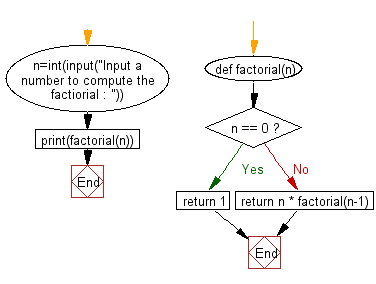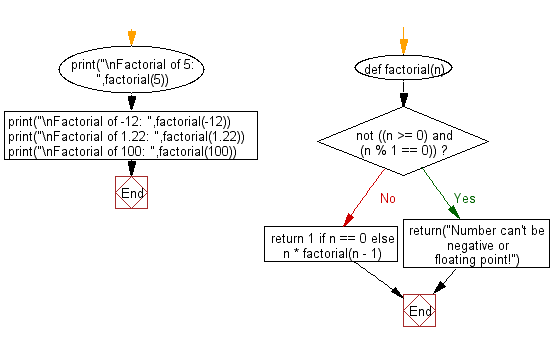Python Exercise: Calculate the factorial of a number
Python Functions: Exercise-5 with Solution
Write a Python function to calculate the factorial of a number (a non-negative integer). The function accepts the number as an argument.
Sample Solution-1:
Python Code:
def factorial(n):
if n == 0:
return 1
else:
return n * factorial(n-1)
n=int(input("Input a number to compute the factiorial : "))
print(factorial(n))
Sample Output:
Input a number to compute the factiorial : 4 24
Pictorial presentation:
Flowchart:

Visualize Python code execution:
The following tool visualize what the computer is doing step-by-step as it executes the said program:
Sample Solution-2:
- Use recursion.
- If n is less than or equal to 1, return 1.
- Otherwise, return the product of n and the factorial of n - 1.
- Display an error message if n is a negative or a floating point number.
Python Code:
def factorial(n):
if not ((n >= 0) and (n % 1 == 0)):
return("Number can't be negative or floating point!")
return 1 if n == 0 else n * factorial(n - 1)
print("\nFactorial of 5: ",factorial(5))
print("\nFactorial of -12: ",factorial(-12))
print("\nFactorial of 1.22: ",factorial(1.22))
print("\nFactorial of 100: ",factorial(100))
Sample Output:
Factorial of 5: 120 Factorial of -12: Number can't be negative or floating point! Factorial of 1.22: Number can't be negative or floating point! Factorial of 100: 93326215443944152681699238856266700490715968264381621468592963895217599993229915608941463976156518286253697920827223758251185210916864000000000000000000000000
Flowchart:

Visualize Python code execution:
The following tool visualize what the computer is doing step-by-step as it executes the said program:
Python Code Editor:
Have another way to solve this solution? Contribute your code (and comments) through Disqus.
Previous: Write a Python program to reverse a string.
Next: Write a Python function to check whether a number falls in a given range.
What is the difficulty level of this exercise?
Test your Programming skills with w3resource's quiz.
Python: Tips of the Day
Find current directory and file's directory:
To get the full path to the directory a Python file is contained in, write this in that file:
import os dir_path = os.path.dirname(os.path.realpath(__file__))
(Note that the incantation above won't work if you've already used os.chdir() to change your current working directory, since the value of the __file__ constant is relative to the current working directory and is not changed by an os.chdir() call.)
To get the current working directory use
import os cwd = os.getcwd()
Documentation references for the modules, constants and functions used above:
- The os and os.path modules.
- The __file__ constant
- os.path.realpath(path) (returns "the canonical path of the specified filename, eliminating any symbolic links encountered in the path")
- os.path.dirname(path) (returns "the directory name of pathname path")
- os.getcwd() (returns "a string representing the current working directory")
- os.chdir(path) ("change the current working directory to path")
Ref: https://bit.ly/3fy0R6m
- New Content published on w3resource:
- HTML-CSS Practical: Exercises, Practice, Solution
- Java Regular Expression: Exercises, Practice, Solution
- Scala Programming Exercises, Practice, Solution
- Python Itertools exercises
- Python Numpy exercises
- Python GeoPy Package exercises
- Python Pandas exercises
- Python nltk exercises
- Python BeautifulSoup exercises
- Form Template
- Composer - PHP Package Manager
- PHPUnit - PHP Testing
- Laravel - PHP Framework
- Angular - JavaScript Framework
- Vue - JavaScript Framework
- Jest - JavaScript Testing Framework
